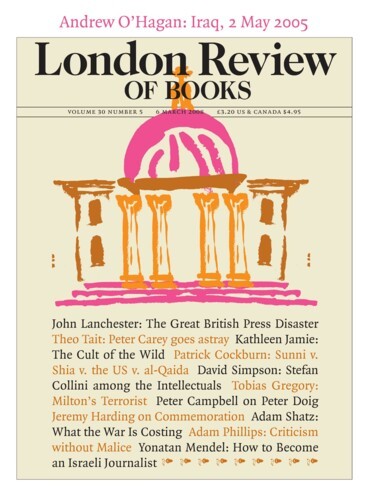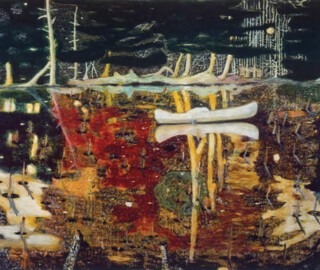Peter Doig painted Echo Lake in 1998. A man stands on the far side of a stretch of dark water. He is quite a way off, but you can see that he wears a white shirt and a dark tie. His hands are raised to his face. Is it to keep the light out of his eyes as he looks at you? Or is it to project his voice as he shouts? A police car, lights on, is parked behind him. Beyond the car the black-green of a band of trees is broken by a few bright spots; they could be streetlights or house lights half-obscured by foliage. It must be night time. Are they crime-scene floodlights that shine across the lake, on the man, grass, rocks and car?
Although the scenes shown in this painting and others by Peter Doig (the retrospective of his work runs until 27 April) seem to imply that curious things have gone before, and that others will follow, there is no reason to think you will ever know what the pictures signify. Like ghost stories, they draw on the potency of matters unresolved; it hangs about them like an unearthed static charge.
Doig has sometimes used a scene from a movie as a starting point, and many of his paintings stay in your mind the way scenes in films do: locations chosen for bleak episodes of distant violence (the execution on the lake in Godfather II); places where there is no possibility of communication (Antonioni, frequently); others where what is special is an eerie suburban ordinariness (David Lynch’s small-town America). Doig’s landscapes, to a greater degree than most you might include in an anthology of painted and filmed scenery, suggest a surprising discovery about to be made, rather than something that’s been imposed on an amenable view.
Although Doig was born in Edinburgh and has spent much time in England, he grew up in Canada and now lives in Trinidad. There are pictures here that echo other images that fill my narrow view of those last two places. Both his lake-and-canoe pictures like Swamped (1990, below) and tropical pictures like Grand Rivière (2001-2) share motifs with the watercolours Winslow Homer painted in the late 1800s and early 1900s while on Canadian fishing trips and on holiday in the Bahamas. In both Homer’s and Doig’s pictures, a feeling for place arises from the look of distant figures in a landscape, canoes on dark water, the ragged outlines of palm leaves and Prussian blue seas. The similarity brings no suggestion of influence; the impression is rather of tales from travellers who, unknown to each other, visited the same country.
There is comfort in proof that this sort of resonance between traditions is still possible. It must arise from a particular apprehension of place. There is little or nothing in the means used – the controlled yet free, fluid strokes in Homer’s watercolours and Doig’s sometimes runny, sometimes dabbed and scrabbled oil paint – that brings them together. ‘I didn’t want the surfaces to be beautiful, but slightly repellent on close inspection,’ Doig once said, and his paintings of the 1990s are just that. In pictures of winter weather from the 1990s blobs of snow may spatter the air, obscuring a scene. Reflections on ice and the bare branches of trees create patterns that slow your reading. On some, seen close to, you find a sparse scattering of little blobs of bright colour like bits of chopped up cherry in a cake mix (in reproduction their force is lost). While spangly effects recur – stars in the night sky in Gasthof zur Muldentalsperre and Girl in White with Trees, for example – the desire to repel fades over time.
Recent pictures are suave. Some are very pretty indeed. Untitled (2006) is in oil and pastel on linen – imagine a Chinese ink drawing on silk much enlarged. It shows a boy climbing a palm tree. His tree bleeds out of the picture on the left, a fringe of leaves from other palms invades on the right. High above a bird flies across the expanse of slightly stained creamy fabric that separates them. It looks as though it was all drawn in pink first, then gone over in lines of blue-grey that are firmer, but still faint, as though seen through fog. Paint which stains and soaks into linen, here and elsewhere, gives a Whistlerish vagueness to things.
The Concrete Cabin series painted in the mid to late 1990s arose from Doig’s connection with a late version of Le Corbusier’s Unité d’Habitation in Briey. The building was derelict: it had been abandoned twenty years earlier. Doig was one of a group of artists and architects who took over a floor and worked on its reclamation. In the Briey paintings a tendency to show things masked or obscured – it is seen elsewhere in smudged faces and snow-veiled houses – is at its most straightforward. The white wall of the Unité is glimpsed through gaps in a screen of pine trunks; fissured brown bark in front, white geometry beyond (the original bare concrete of the building had been painted). A building approached through trees is a storyteller’s device. You, the spectator, take the place of a camera or a narrator. You are in the shade and cannot be seen. Depending on the story the building beyond could be a haven, an adventure or a threat. That Doig made a video of the approach to Briey (and used stills from it as a source for graphic work) suggests that he was attuned to this.
In pictures like those in the Cabin series, Doig becomes a history painter or illustrator, but not one who turns to the stories of others for subjects. Henry James chose to have the New York edition of his novels illustrated with photographs by Alvin Langdon Coburn. They were not strictly speaking illustrations and certainly did not compete with the images the words created, yet they did genuinely enrich the texts. They were not merely embellishments. When the publishers of classic fiction rake the archives for old paintings to put on covers they are after the same thing: a visual correlative that doesn’t interfere with the author’s work. The faces readers give a heroine, the architecture they imagine for a country house, are often both strong and vague. They would be hard put to say exactly what the character looks like, but are easily irritated by unwanted specificity.
Doig’s obliquity would qualify his work for the game of literary/graphic marriages. In Lapeyrouse Wall a man walks away from you, following the line of a long wall: it is piebald below, pink, as though tiled, on top. It’s hot; only his feet can find the comfort of its brief shadow. For the rest he must depend on the one cast by the flowered umbrella he carries. He wears a black baseball cap and glasses. You can’t see his face; you only learn from the catalogue that the wall hides a cemetery. The picture is laden with narrative possibilities, but you, not the painter, must tell, or find, the story.
Send Letters To:
The Editor
London Review of Books,
28 Little Russell Street
London, WC1A 2HN
letters@lrb.co.uk
Please include name, address, and a telephone number.


